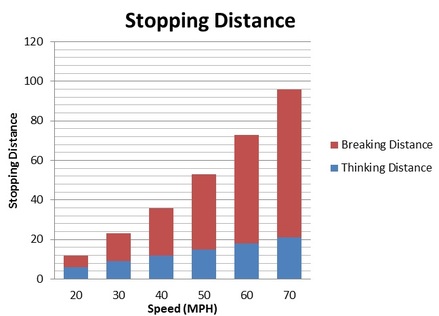|
We are continuing our series on habits that are picked up after passing your driving test. This can happen once you have passed your driving test and begin to drive independently. Although this can benefit you with experience and confidence, there is also the potential to pick up those horrible habits. Take a look at our tailgating post which fits in perfectly with this topic.
How is stopping distance calculated? Something you may already be aware of is how stopping distance is calculated. This can be shown as an equation which is: Stopping distance = thinking distance + breaking distance What can affect your thinking distance? There are many different reasons why your stopping distance can alter. These are usually things that you are able to control. Below is a short list of items that can affect your thinking distance:
What can affect your breaking distance?
When it comes to breaking distance, many people already know that the thinking distance is the only part of the equation that you can control. However, listed below are ways that the breaking distance can be reduced:
Shown above are a variety reasons why your stopping distance can be longer than you may think. It is mostly likely that many of you are aware that being tired or distracted can increase your stopping distance as well as tyre conditions. Driving on your mobile is an offence which is punishable with penalty points. It is also worth knowing that if your tyre tread is below the 1.6mm, it is illegal and will probably affect your stopping distance whilst driving. In London there has been an initiative that is to increase the number of areas with 20mph speed limits, this is to try and decrease the amount of incidents in the areas and to try and control traffic more effectively. Does your thinking and breaking distance change the faster you go? Yes, both the breaking and stopping distance increases the faster you go. It is said that if you are not distracted and the road conditions are dry, the typical stopping distances are: 20mph = 6m thinking distance and 6m stopping distance = 12 metres travelled 30mph = 9m thinking distance and 14m stopping distance = 23 metres travelled (52% increase) 40mph = 12m thinking distance and 24m stopping distance = 36 metres travelled (64% increase) 50mph = 15m thinking distance and 38m stopping distance = 53 metres travelled (68% increase) 60mph = 18m thinking distance and 55m stopping distance = 73 metres travelled (73% increase) 70mph = 21m thinking distance and 75m stopping distance = 96 metres travelled (76% increase)
What other habits are there?
Remember that stopping distances and speed limits are there for a reason! Leave a comment on any experiences you’ve had to do with stopping distances or tailgating. Did you like the simulator? Sign up to hear when we post our blogs, Happy Driving! Royal
16 Comments
12/6/2018 01:01:17 pm
A vehicle's stopping distance is a significant portion of a motorist's driving theory. Do you know what stopping distance truly is? It is the summation of thinking distance and braking distance. No matter, whether you are a learner or an experienced one, if you don't know the stopping distance, then you can't stay safe while piloting your speed machine on the thoroughfare. Relying the weather, road condition and driver condition, the average stopping distance will vary. As a driver, you have to understand the true significance of stopping distance so that you drive safely without encountering any collision.
Reply
Barry
27/6/2018 01:07:08 pm
did you know that throughout this page the word BRAKING has been spelled incorrectly as Breaking. they have different meanings
Reply
2/10/2020 06:32:02 am
Described very well. It would have helped many people to understanding the stopping distance. We at MockDrivingTest.com connect the learners and ADI to improve the driving test pass rate.
Reply
16/10/2020 08:09:32 am
I am thankful to this blog giving unique and helpful knowledge about this topic.
Reply
16/10/2020 08:50:23 am
I think this is an informative post and it is very useful and knowledgeable.
Reply
28/7/2023 11:48:24 am
This website is a great source of information! I found the articles to be well-researched and insightful. Keep up the good work!
Reply
23/8/2023 03:30:15 am
Thanks for your advice! It could actually save us form future trouble.
Reply
11/10/2023 06:51:25 am
You have so incredible knowledge to share with others. Regards for spreading it. Please keep supporting us by giving the services of the Driving Lessons in East London.
Reply
7/11/2023 06:39:15 am
You have so incredible knowledge to share with others. Regards for spreading it. Please keep supporting us by giving the services of the Best driving school in east London.
Reply
20/3/2024 06:03:01 am
your information is good and valuable please also support this https://www.bossdriving.co.uk/ thank you
Reply
18/5/2024 08:04:54 am
Thank you for your very helpful tips!
Reply
15/6/2024 02:28:58 pm
Keep the integrity and safety of your property intact by not allowing a damaged roof to do so.
Reply
Leave a Reply. |
DRIVING BLOGTim RoyalAll of our blogs are constructed by a very experienced driver that wants to share his wealth of knowledge to assist you. Advert
Categories
All
|

